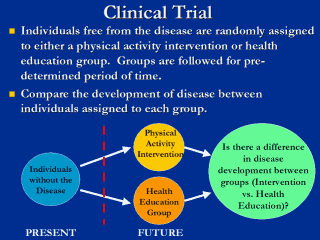| front |1 |2 |3 |4 |5 |6 |7 |8 |9 |10 |11 |12 |13 |14 |15 |16 |17 |18 |19 |20 |21 |22 |23 |24 |25 |26 |27 |28 |29 |30 |31 |32 |33 |34 |review |
 |
In a clinical
trial, individuals free from disease are randomly assigned to receive either
a physical activity intervention or no intervention (the health education
group). The two groups are followed for a period of time to determine if
they differ. This difference in groups is typically revealed by the percent
of people that develop the disease or health outcome of interest.
PROS: Random assignment of who does and does not receive the physical activity intervention minimizes potential biases. Data generated is prospective in nature and better than retrospectively obtained data which can be subject to participant recall bias. Just like the prospective design, a clinical trial can establish cause and effect. Investigators will be able to determine if physical inactivity lead to the disease or health outcome of interest. CONS: Expensive Not suitable for study of physical activity interventions to prevent diseases or outcomes that take a long time to develop or are rare. Individuals may behavior differently if they know they are being watched. This study is subject to participant dropout and loss to follow-up. Recommended Reading: Gordis L (2000). Epidemiology (2nd ed.). Philadelphia, PA: W.B. Saunders Company. |